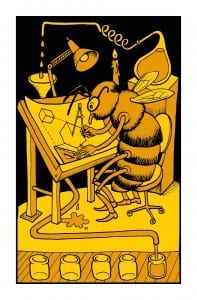Who knew honey could BEE so interesting. Get it? Get it?
By Sarah E M Wiseman, on 19 June 2012
The tent was buzzing. Literally. There was a box of bees sitting on the table on stage. I was at the late night ‘Science of Honey’ talk. Despite being on at the same time as the England-Sweden match, the place was packed.
This event was to be a combination of fascinating bee facts and ridiculous honey experiments. On stage was the experimental comedy duo of Andrea Sella and Mark Miodownik. Experimental in the sense that they had fire, giant molecules and a charging wand on stage. And they made a mess. Complementing this side of things was Daniel Basterfield, keen apiarist and knower of all things bee and honey related.
Daniel began by introducing us to the history of honey and beekeeping. There are cave paintings from 9,000 years ago showing humans taking honey from bees. Beehives provided pollen for protein, wax for fat and, perhaps most importantly, honey for sugar and energy.
It makes sense that, eventually, humans would realise the importance of having bees around and would begin to work with the bees to gain their honey, rather than ransacking hives like their ancestors would have.
Bees have a special place in human history, and are important in many cultures and religions. There was a special bee hieroglyph in ancient Egyptian. Honey was so important to them that it was found in the tombs of pharaohs. Honey was one of the only food stuffs the Egyptians had that didn’t go off. A jar found in one tomb was still full of honey, which still hadn’t gone off! Daniel pointed out to us that this means providing best before dates on his honey is a bit of a challenge, it can last for at least 3,245 years…
The reason that honey lasts so long is that it is not a pleasant place for bacteria to live. Honey is around 70-80% glucose and fructose, and so has a very low water content. When bacteria land on the surface of the honey, they are sucked dry due to a form of osmosis and find it hard to live in that environment.
Now came the experiment portion of the event, and Andrea and Mark made for an entertaining double act.
They explained the stickiness and runniness of honey in terms of the two sugar molecules contained in honey: fructose and glucose. The shape of these molecules and their formation meant that there were incredibly strong hydrogen bonds between the molecules in honey, making it sticky.
Interestingly, the amount of each type of sugar determines the consistency of the honey too. Granulated honey is high in glucose, whereas runny honey is high in fructose.
Andrea then showed us the effect of running the honey near an electric charge. Dripping honey onto a paper plate from a height, Andrea slowly moved a charged stick towards the honey. This charge instantly made the honey stop falling straight and start moving towards the stick.
The effect was so great that the honey stopped landing on the plate, and started landing on Mark’s external hard drive halfway across the table. Mark wasn’t impressed. After apologising, Andrea then admitted his kitchen was now decorated in a shade of honey after trying the experiment at home.
It wasn’t just the honey that we learnt about, we also heard more about the structure of the honeycomb.
It turns out that bees are incredibly clever when it comes to the internal engineering of the hive. Mathematicians for a long time thought that the structure of the honeycomb was the most efficient way to build cells and use the least amount of wax.
We were shown a piece of honeycomb under a camera and the regularity in size of the hexagonal cells was incredible. What made it all the more impressive was that this had been built by a whole team of bees, each of whom had created cells in almost exactly the same size and shape.
I began wondering how the bees could manage to build such a mathematically efficient shape. Andrea wondered that too, and had apparently spent the night before the talk trying to create honeycomb joins out of cardboard. From his slightly-falling-apart attempts, it seems that it really isn’t an easy task.
Recently, however, it has been shown that bees haven’t quite optimised their cell layout. A mathematician had shown that they are actually not using the most efficient layout; by using joins comprised of trihedral pyramidal shapes, they could be 0.035% more efficient with their wax use. Kind of embarrassing for the bees really. Back to the drawing board.
The only bad thing about this talk was that it was only given a 90-minute slot. There wasn’t any time to talk about the mechanics of bee flight (something that has been much debated in the past). Nor was there much talk of the current problems facing bees at the moment such as Colony Collapse Disorder or the varroa mite. I met Andrea in the bar a day later, he too bemoaned the short time they had, “We needed five hours to cover it all!”
This was a fantastic, fun and incredibly engaging talk. The combination of Daniel telling us bee and honey facts, and Mark and Andrea messing around in the most scientific of ways with honey made for a brilliant night’s entertainment. And I now have a host of new bee facts with which to bore people at parties.
 Close
Close

